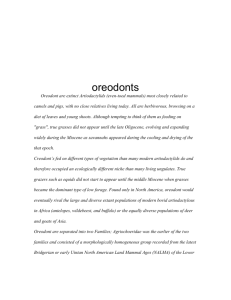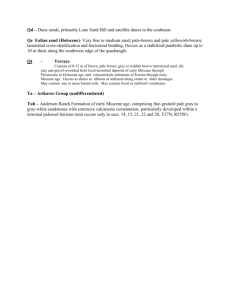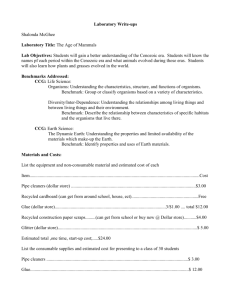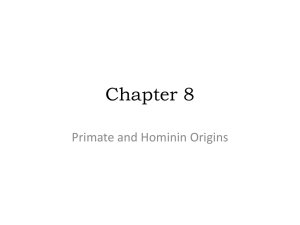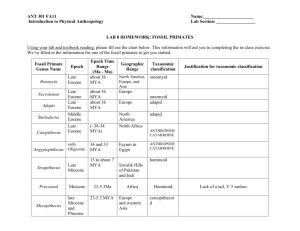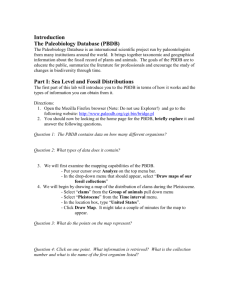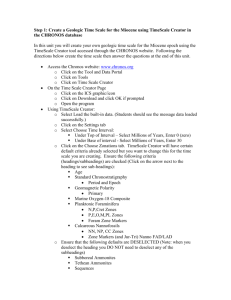MAMMAL EVOLUTION DURING THE CENOZOIC
advertisement
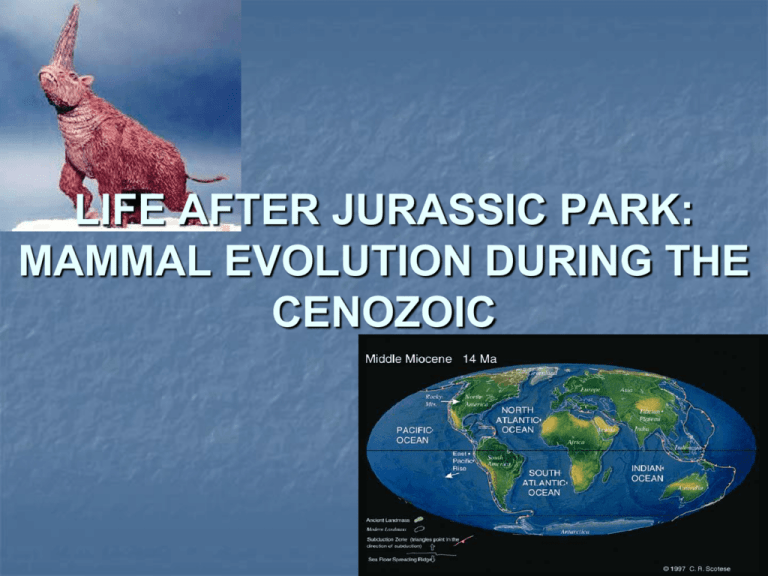
LIFE AFTER JURASSIC PARK: MAMMAL EVOLUTION DURING THE CENOZOIC PALEOGEOGRAPHY AND CLIMATIC CHANGES IN THE CENOZOIC There were a series of climatic changes during the Cenozoic that were the product of changes in the continental masses. This has a direct relationship with changes in the vegetation and in the animals represented in the different continents and latitudinal regions of the world. We will see first the changes in the geography in the past, and then how that produced change in landscapes (principally vegetation) and influenced the evolution of certain traits in herbivorous mammals. CENOZOIC ERA BEGINS 65.5 MILLIONS YEARS AGO AND CONTINUES UNTIL TODAY EPOCHS OF THE CENOZOIC ERA PLEISTOCENE PLIOCENE MIOCENE OLIGOCENE EOCENE PALEOCENE CRETACEOUS 1.8 Ma 5.3 Ma 3.5 Ma 17.7 Ma 23 Ma 11 Ma 34 Ma 55.5 Ma 21.5 Ma 65.5 Ma 10 Ma Landscape changes In the early Cenozoic the global temperatures remains high and there are tropical-like forests in high latitudes (750 North) The Miocene was hot and dry and produced a reduction in forest and an increase in savanna environments with grassland The Palaeocene world 65-56 ma Earth was in a ‘greenhouse’ phase Warm and wet Land covered in rainforest Early Palaeocene Mammals Small and mostly arboreal Unspecialised Few leaf eaters Few carnivores Late Palaeocene Stronger seasonality Larger Herbivores and Carnivores Usually lumped into trash-can: the “Condylarths” Dominant carnivores were the Mesonychids Molar changes in herbivores Brachyodont (low crowned) and bunodont (rounded cusps) molars Hypsodont (high crowned) and lophodont (with crests) molars BROWSER GRAZER Limb changes in Perissodactyla Hyracotherium 55-45 Mya Miohippus 33-29 Mya The central digit became increasingly stronger while the lateral ones became less important, and are virtually lost in the modern horse Merychippus Equus 17-11 Mya 5 Mya Specializations in limb anatomy in relation to gait Calcaneum Mesopodial (tarsal) element Metapodial element Phalanges WP RETURN OF DINOSAURS Carnassial teeth Specialised slicing teeth, where the trigonid and talonid are modified into blades Present in two orders: Creodonta and Carnivora Creodonta Carnassial pair towards back of jaws; M1/M2 or M2/M3 Late Palaeocene to Early Miocene, dominant carnivores in North America, Asia, Europe and Africa in the Eocene and Oligocene Two main Families : Oxaenidae and Hyaenodontidae Oxaenidae Patriofelis; Palaeocene More cat-like forms, specialised for pure meat diets and ambush predation Also some bone-crushing, hyaena-like forms Never made it to Africa Hyaenodontidae More dog-like forms, broader diet and adaptations to running Made it into Africa and survived there longer than elsewhere in the world Megistotherium A giant hyaenodontid. The largest creodont Also had the largest skull of any terrestrial carnivor From the Miocene of northern Africa True Carnivores: Order Carnivora First appeared in the Late Palaeocene (small) By the Late Miocene had replaced creodonts as the dominant terrestrial carnivores in Africa, North America, Europe and Asia Carnassial pair are P4/M1 Have evolved herbivorous and fully aquatic forms Two main branches: Feliformia (cat branch) and Caniformia (dog branch) First Large Carnivora Appeared in the Oligocene, mostly extinct dog-branch families: amphicyonids, nimravids and hemicyonine bears but the cat-branch radiation of hyaenids soon followed in the Early Miocene Amphicyonidae: Bear-dogs Pouncing predators of samll to middle size game, probably able to climb to some degree. Some later members became heavy-built bear-like omnivores Spread throughout northern continents Entered Africa in the Miocene Nimravidae: False Sabre-Tooths Very similar to sabre-toothed felids (including retractable claws) A case of convergence Oligocene-Miocene North America, Europe, Asia and probably Africa Bears - Ursidae Two types: Hemicyoninae and Ursinae Early Hemicyoninae (first occurrence in the Late Oligocene) running dog-like predators (although broader diet than true dogs) Hemicyoninae were present in Africa in Early Miocene Hemicyon Ursinae - modern bears Large, heavily built and omnivorous Has produced an herbivorous species (Giant Panda) Were present in Africa in the Late Miocene Agriotherium Dogs - Canidae Evolved in the Eocene of North America Earliest form was Hesperocyon (Late Eocene - Oligocene) It was small, fox-like and omnivorous Dogs 2: The Borophaginae A uniquely North American radiation of large predators including bone-crushing hyaena-like forms (Oligocene-Miocene) Dogs 3: Caninae -modern dogs Evolved the fast pack-hunting wolf-like forms that radiated out of North America in the Late Miocene. Did not reach Africa until the Pliocene Marine Carnivores: Pinnepedia Enaliarctos, earliest seal Part of the dog branch, related to weasels and bears Evolved on the Pacific coast of North America in the Early Miocene The hyaenid radiation Started as small, civet-like hunters of small game and insects First found in Europe but quickly moved to Asia and Africa The aardwolf is a modern example of such small-game specialised hyaenas Later hyaenas Ictitherium, Miocene, Africa Became larger game meat eaters, The early large hyaenas were fast runners Bone-cracking hyaenas Pachycrocuta 50% larger than modern hyaena Late Pliocene-Early Pleistocene Evolved in the Late Miocene Spread as far as North America for a brief time in the Pleistocene Cats - Felidae Started as small (caracal-sized) aboreal ambush predators in the Late Oligocene of Europe Sabre-Tooths (Machairodontinae) were the dominant large cats in the Miocene to the Early Pliocene Short tooth big cats (Pantherinae) don’t appear until the latest Pliocene Proailurus Earliest cat. More teeth than modern cats. Also flat footed (plantigrade). Machairodontinae - Sabre Toothed Cats Smilodon, Pleistocene, America (North and South) Typical heavy- bodied ambush predator Homotherium a running machairodontine Pliocene, Africa, Europe and North America Sloping back, small claws, small sabres Megaherbivorous Terrestrial Mammals Mammal groups that include large-sized species are EXTANT GROUPS Artiodactyla (even-toed ungulates); the most diverse group of living ungulates includes pigs, hippos, camels, giraffes, deer, and bovids (cattle and antelope). Laurasia Perissodactyla (odd-toed ungulates) represented by horses, rhinos and tapir. Laurasia Proboscideans are elephants and relatives. African Edentata which are represented by sloths, anteaters and armadillos are from America. Fossils of this group (e.g. gliptodonts and ground-sloths) were part of the American Megafauna. Marsupials which are known only in Australia and America. Fossils of this group (e.g. Diprotodon) were part of the Australian Megafauna. Megaherbivorous Terrestrial Mammals EXTINCT GROUPS Meridiungulata, an extremely diverse group of South American ungulates. This include at least four orders Pantodonts, the very first of the large, herbivorous placental mammals to evolve after the Cretaceous. Laurasia Dinocerata, the largest of all the archaic Paleocene-Eocene herbivores. Laurasia Embrithopoda, huge rhinoceros-sized showing skull with massive horns known from the Eocene. Africa PALEOCENE-EOCENE Pantodonta 5 toed plantigrade, 2.5 metres length; 650 kg (weight of an eland) Coryphodon, with large canines; a semiaquatic life is suggested for this animal Mesonychids Early carnivores, weasel to bear sized Lived in Asia, Europe and North America Sharp teeth (but no carnassials), five fingers and toes that were tipped with small hoofs Related to Artiodactyls (cows, camels, pigs etc.) Andrewsarchus Giant mesonychid, skull was 83 cm long. The body was probably rhino-sized or larger Largest ever terrestrial carnivorous mammal May have done a lot of scavenging PALEOCENE-EOCENE MEGAHERBIVOROUS MAMMAL Dinocerata includes uintatheres, enormous size, 1450 kilograms rhino-like, with three pairs of large bony protuberances without upper incisors and large upper canines EOCENE-OLIGOCENE HERBIVOROUS MEGAMAMMALS Closely related to elephants but with hippo-like lifestyle 70 cm EOCENE-OLIGOCENE HERBIVOROUS MEGAMAMMALS 2.1 mts Artiodactyl, related to pigs Mongolia, U.S. Omnivorous, scavenger Low bunodont molars Size varying from that of peccary to bison Skull is half a meter long in Eocene forms and nearly one meter long in Miocene forms Bony lumps Mental and mandibular tubercles EOCENE-OLIGOCENE HERBIVOROUS MEGAMAMMALS 2.5 mts Mongolia, U.S. Perissodactyl lineage well diversified in the Eocene, restricted to North America and Asia EOCENE-OLIGOCENE HERBIVOROUS MEGAMAMMALS Oligocene Asian group 1.3 mts 4.5 mts Paracetatherium is the largest terrestrial mammal ever Browser on leaves well above the reach of any other mammals Perissodactyl, closely related to rhinos EOCENE-OLIGOCENE HERBIVOROUS MEGAMAMMALS EOCENE-OLIGOCENE HERBIVOROUS MEGAMAMMALS Embrithopoda (Arsinoitherium) rhino-sized, massive and hollow horns almost of the same size of the skull and second small horns above the orbit Complete dentition without tusks or enlarged canines, hypsodont molars Semiaquatic animals Late Eocene, Fayum, Egypt MIOCENE HERBIVOROUS MEGAMAMMALS Perissodactyl from Europe, Asia and, latter, Africa Somewhat larger than a horse Short, strong hind legs. The long front legs had enormously long, curved claws; knuckle-walking 2.6 m MIOCENE HERBIVOROUS MEGAMAMMALS Perissodactyl, from Asia and Africa, one of the last surviving chalicotheres But didn’t walk on their knuckles 2 mts Sparse remains of this animal have been found in famous hominid fossil sites in East Africa PROBOSCIDEAN DIVERSITY 4 mts The deinotheres were the gigantic cousins of the elephants and flourished at the time of Australopithecus Tusks of Deinotherium are a pair of lower incisors extending ventrally due to a downward reflection of the symphysis of the lower jaw Miocene of Europe MEGAHERBIVORES FROM SOUTH AMERICA MERIDUNGULATA, Litopterna One of the last South American survivors. Extinct in the Pleistocene 1.5 mts It is a camel-like mammal with elongated neck and limbs Toatherium Miocene, with a equid-like condition of the limbs MEGAHERBIVORES FROM SOUTH AMERICA MERIDUNGULATA, Notoungulata Most diverse meridiungulates Extremely variable in size Toxodonts size of a rhino, from Miocene to Pleistocene MEGAHERBIVORES FROM SOUTH AMERICA Edentate glyptodont, with an osseous carapace and tail with ring of bones and spines 1.5 mts Edentate pilosa known from many skeletons, fossilised footprints and mummified hair 6 mts With huge claws on its feet. Like a modern anteater, it had to walk on the sides of its feet MEGAHERBIVORES FROM AUSTRALIA Giant marsupial Diprotodon 2.5 m at the shoulder Browsing on soft vegetation PLEISTOCENE HERBIVOROUS MEGAMAMMALS Mamuthus primigenius or woolly mammut 3 mts Known from bones and frozen carcasses from Ireland to North America. The best preserved carcasses are from Siberia. Colour patterns known from cave paintings 2.5 mts Megaloceras or giant deer is a cervid artiodactyl from Europe AMERICAN BIOTIC INTERCHANGE Megaherbivorous mammals from the Cenozoic. Summary 1. The majority of Paleocene mammals were still small-bodied insectivores and omnivores, but there were several new groups that were medium-sized (540 kg) and large (>40 kg). 2. Some specialized herbivores existed in the northern faunas such as Pantodonta and Dinocerata that includes the first large, herbivorous placental mammals to evolve after the Cretaceous. 3. In South America edentates and the first Meridiungulata (or South American ungulates) are known from the Late Paleocene. 4. In the Eocene, Perissodactyls soon become an important group of medium to large-sized herbivores. There are already early representatives of the families of horses, rhino, and tapirs, and also include bizarre, large-bodied browsing groups, the chalicotheres and the brontotheres. Artiodactyls remained relatively modest during the Eocene and Proboscidea are also first known from the Eocene. 5. In the Late Eocene of Fayum, Egypt, the herbivores were dominated by proboscideans, hyracoidean, and Arsinoitherium. In South America, the meridiungulates radiated throughout the Eocene. 6. In the Miocene, there is an immigration into Africa (that was previously an isolated continent) of many Eurasian groups, basics for the development of the modern African fauna: rhinocerotid and chalicothere, and giraffid, bovid, suid and tragulid families of artiodactyls. Proboscideans migrate from Africa northward, at about 20 Ma. 7. Towards the end of the Miocene (about 7 Ma) there was a spread of grasslands, coincidental with a worldwide faunal change in which hypsodonttoothed mammals, especially artiodactyls, became the dominant ungulates. 8. In the Plio-Pleistocene, the most remarkable episode is the great American Biotic Interchange, which concerns the exchange of faunas, including megaherbivores, following the connection of South America and North America by the Isthmus of Panama. 9. The end of the Pleistocene (~ 10,000 years ago) was marked by the abrupt extinction of many mammals but especially species of the megafauna.
